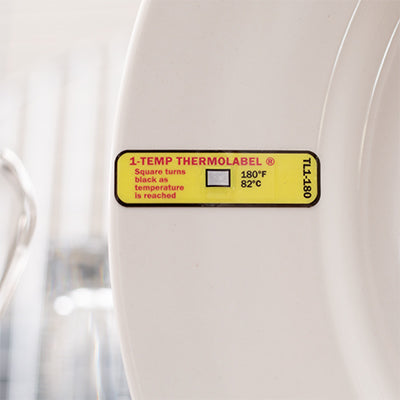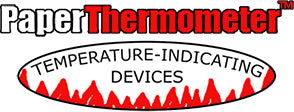Why are my dish temperature labels not turning black?
Here is a scenario we see frequently: A person in food service believes that they need to get a 180°F temperature label to test their dishwasher sanitation. We try to provide the information we have learned over the years so that the customer can make an informed choice. We talk about the FDA Food Code Section 4.7 and its specific language requiring use of a 160°F temperature label. The customer is still convinced that he needs a 180°F temperature label, then proceeds to buy the TL1-180 Thermolabel temp test strip. We later get contacted by the same customer complaining that the label is defective because it is not turning black in their dishwasher. This is a frustrating situation for us and the customer.
Of course the 180°F temperature label is not defective. It is in fact doing exactly what it is supposed to, showing that a surface either has reached 180°F or, as in this example, has not reached 180°F. The 180°F temperature label will most likely never turn black in a commercial dishwasher that has had its temperatures set correctly for efficient and safe operation. So why is this? The rinse water is set to 180°F so why does the 180°F temperature label not turn black? The answer lies in a very common misconception involving the dishwasher, temperature label and water temperatures during the machine's cycle. It is something that we end up explaining to customers nearly every day.

There are various types of commercial dishwashers. In the standard hot water sanitation dishwasher there are two water temperatures to pay attention to; the wash temperature and the rinse temperature. Both temperatures have an impact in the goal of reaching the FDA required sanitation temperature that ensures that dishware doesn't transmit dangerous food borne illness. The wash water that is used during the main part of the dishwasher's cycle is often set to between 150°F and 165°F. The final rinse water is usually set to 180°F. The rinse part of the cycle, known as the final rinse, is really what brings the dishware up to temperature for sanitation.
Let's say the dishes enter the commercial dishwasher at about room temperature. The wash cycle hits them with water (and detergent, etc) at 150°F. This raises the temperature of the dishware (but not to anywhere near the required 160°F). This makes sense, the temperature of the dishware is not going to be raised to a temperature higher than the temperature of the 150°F water that is hitting it. In fact, it probably is not even going to get to the temperature of the 150°F wash water as there will be heat loss as the cooler dishware warms up. After the cleaning phase of the dish washing cycle is complete the final rinse occurs. Water at about 180°F is sprayed on the dishware to rinse the dishes. At the same time this 180°F water is bringing up the temperature of the dishware to sanitize it.
Here is the key to understanding 160°F vs 180°F in dishwashers. Just as during the cleaning portion of the cycle where the dishware doesn't necessarily get up to the 150°F temperature of the wash water, the dishware will not get up to the 180°F temperature of the final rinse water during this phase of the dishwasher's cycle. What really ensures that the dishes will not reach the 180°F temperature of the rinse water is the length of time that the rinse water contacts the dishes. It is much shorter than the wash cycle, often as short as 10 or 15 seconds! There is just no way that 180°F rinse water is going to bring the dishes to 180°F in that short of time. That's ok because it doesn't need to. The FDA requires 160°F on the dish surface, not 180°F. You can check this out for yourself at the FDA's website. The 180°F rinse water combined with the warming that occurs during the wash cycle is able to successfully bring the dish surface temperature up to the 160°F sanitizing temperature.
So back to our all too common example that we started with, why are so many food service customers convinced they need a 180°F temperature label for their dish sanitation? We have not been able to pin this down exactly and likely there are multiple reasons. Obviously the 180°F setting for the rinse water plays a part in this. People are confusing the rinse temperature with what they need to end up with for a dish temperature. Sometimes food service customers have been given incorrect information by people who themselves misunderstand what is required or what is being tested for. The difference between the temperature of the rinse water and the temperature of the items being hit with the water is often not well understood. The example we like to turn to for an easily understandable explanation involves an ice cube tray. If you fill an ice cube tray with water and stick it in the freezer does that water instantly change to ice?
No, of course not. It will take a good length of time in freezing conditions for that water to freeze in the ice tray. The commercial dishwasher can be viewed similarly. If you spray 180°F water on some dishes are those dishes instantly going to be brought to that temperature. Of course not.

So what to do when you are looking to buy a temperature label for dish sanitation? First do your research and then choose the correct temperature, which is almost always the FDA required 160°F (there can occasionally be local regulations in effect that require a different temperature such as 165°F or 150°F).
If you are still sure that you actually do need a 180°F temperature label to test your dish sanitation temperature, your best option may be the TL3-160 temperature label. This label has three temperature elements; 160°F, 170°F and 180°F. With this temperature label you will be covered when you need a 160°F indicator (as the FDA Food Code stipulates) or if for some reason you truly need to test for 180°F on the dish surface you are all set too (if you do need 180, we would love to hear about it!).
If you still have questions, contact us. We will do our best to help out.
For a look at all the commonly used temperature labels for food service, try here.
